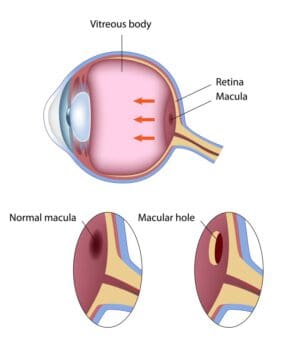Pros & Cons of Using Avastin to Treat Macular Degeneration
Last Updated:
Macular degeneration is one of the leading causes of vision loss. The “dry” form of the disease causes gradual vision loss. The “wet” form can steal your sight suddenly. Bleeding beneath the delicate tissue at the back of your eye is to blame.
With Avastin eye injection, your doctor uses to treat wet macular degeneration. The medication was originally developed as a colon cancer treatment, but doctors can use it to help address eye problems too.
Avastin is a standalone treatment for wet AMD, so you will not need another form of therapy if this one works. You will need to visit your doctor for multiple injections, however, as the drug does wear off with time.
What Is Wet Macular Degeneration?

Macular hole diagramYour eye is built in layers, with sensitive tissue at the back. The macula, as this is known, relies on a constant supply of blood. If that connection is severed, macular tissue is damaged, and often, it can’t be repaired. Damage to that tissue often comes in the form of macular degeneration.
The BrightFocus Foundation reports that about 11 million people within the United States have some form of macular degeneration. Only about 10 percent of them have a form of the disease known as wet AMD, but that condition accounts for 90 percent of legal blindness cases.
You deserve clear vision. We can help.
With 135+ locations and over 2.5 million procedures performed, our board-certified eye surgeons deliver results you can trust.
Your journey to better vision starts here.
Wet AMD causes:
- Unusual vessel growth. The macula relies on a constant blood supply, delivered through vessels that run beneath that tissue. Wet AMD begins with a proliferation of blood vessels.
- Weakening. Those new vessels are not strong, and the walls are thin. As they carry blood, they stretch further.
- Bleeding. Thin walls tear, and blood spills beneath the macula, separating it from the nourishment it needs. Macular tissue begins to die.
The National Eye Institute says wet AMD symptoms appear suddenly and worsen quickly. They include:
- Hazy or blurred vision.
- Clouds or gaps in the center of your vision.
- Reduced color perception.
- Distortions, including wavy lines that should be straight.
While anyone can develop wet AMD, the American Academy of Ophthalmology says your risk is higher if you are:
- Overweight.
- A smoker.
- Fond of foods that are high in saturated fats, such as meats and cheeses.
- Older than 50.
- Living with high blood pressure, heart disease, or high cholesterol.
- From a family with a history of AMD.
Regular eye exams are critical, as you may not notice changes in your vision until they are severe and hard to treat. If your doctor detects wet AMD, therapy may help to keep future vessels from leaking. In some cases, therapy can restore some of the vision you lost.
What Is Avastin?
Blood is crucial for tissue health. Your body uses chemical markers to spur the growth and development of blood vessels. Avastin targets those signals.
Experts explain that the Avastin eye injection blocks vascular endothelial growth factor (VEGF). It’s this chemical that tells your body to grow new vessels below the macula, where they do not belong. While Avastin is effective, it wasn’t developed for this purpose.
hazel eyesCancerous tumors also rely on blood flow, and they can encourage the body to develop an extensive network of vessels. With that web built, the tumor can grab all the nutrients it needs to grow bigger and stronger.
Researchers developed Avastin in the fight against colon cancer. Injections of the drug can starve the tumor of the blood it needs, which can make it shrink and wither.
While the U.S. Food and Drug Administration has approved Avastin as a colon cancer drug, the organization has not given the same approval for wet AMD use. Experts explain that specialists at the University of Miami were the first to tinker with Avastin as an eye treatment, and when their work caught on, other doctors started doing the same. This is considered off-label use, and it’s acceptable as long as doctors know the risks and benefits, and explain them to their patients.
The Avastin eye injection is not the only wet AMD drug available. Other options include Lucentis and Eylea. These drugs are made for eye use, and that means they are delivered to doctors in:
- Optimal doses. Doctors do not need to calculate how much to give. The manufacturer does that work.
- Single-use packaging. Every dose is carefully wrapped for tight preservation as it leaves the warehouse.
- Injection kits. Doctors can open up the packaging and get started rather than dipping into their own supplies for needles.
Avastin is different. Colon cancer sizes are variable, and doctors sometimes need more for some patients and less for others. The drug is delivered in one bottle, and that helps doctors do their work to help cancer patients.
Doctors who work off label to improve eye health need a much smaller amount, and in theory, one bottle could hold multiple doses.
This crucial point explains some pricing differences between Avastin and other therapies. Experts explain that Avastin can cost about $70 per dose, while other therapies can come with a $2,000-per-dose price tag.
How Does Avastin Therapy Work?

Avastin is an injectable drug, and your doctor delivers it via needle into the center of your eye.
The BrightFocus Foundation says most people get injections:
- Every four weeks. This lasts for three months, and during this time, your doctor monitors your eye health and progress in fighting back against wet AMD.
- Every eight weeks. If your health is improving, your doctor will give the shots less frequently.
Your doctor determines how long the therapy lasts and how many shots you need. This is a standalone treatment for wet AMD, so it’s not combined with other solutions like laser therapy or surgery. But if it does not work, your doctor may try these options to preserve or restore your sight.
While your eye is numb during the injection, pain after the therapy is not unusual. You may also see specks or floaters in your field of vision.
Researchers have uncovered more serious side effects, including infection. Your doses must be repackaged for use in your eye, and sometimes, bacteria meshes with the drug. When that happens, serious infections can take hold within your eye. Researchers say the bacterium streptococcus endophthalmitis is typically to blame. This risk does not appear with other, eye-specific wet AMD therapies.
Your doctor can help you decide if Avastin eye injections are right for you. And if it is, you can work with your doctor to reduce your infection risk. You may also decide to choose a different form of treatment due to these concerns. Talk with your doctor to find out more.
You deserve clear vision. We can help.
With 135+ locations and over 2.5 million procedures performed, our board-certified eye surgeons deliver results you can trust.
Your journey to better vision starts here.
References
- Age-Related Macular Degeneration: Facts and Figures. (January 2019). BrightFocus Foundation.
- Age-Related Macular Degeneration Data and Statistics. (July 2019). National Eye Institute.
- What is Macular Degeneration? (May 2019). American Academy of Ophthalmology.
- What Treatments Are Available for Wet Macular Degeneration? VisionAware.
- By the Way, Doctor: Is Avastin for Macular Degeneration a Good Choice? (May 2010). Harvard Medical School.
- Use of Bevacizumab for AMD Resulted in Savings of $17.3B for Medicare, Patients. (May 2018). HCP Live.
- Treatments for Wet Macular Degeneration. BrightFocus Foundation.
- Avastin and Lucentis for Macular Degeneration: Head-to-Head Once Again. (March 2012). VisionAware.
- Novartis’ New Macular Degeneration Drug Has to Compete Against Colon Cancer Drug Avastin. Why? (April 2019). Korea Biomedical Review.
This content is for informational purposes only. It may have been reviewed by a licensed physician, but is not intended to serve as a substitute for professional medical advice. Always consult your healthcare provider with any health concerns. For more, read our Privacy Policy and Editorial Policy.
